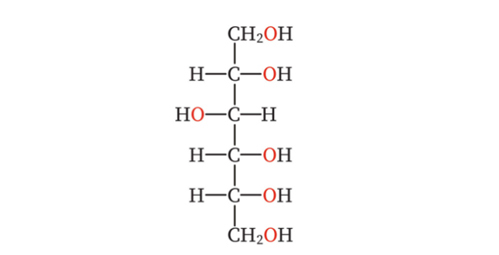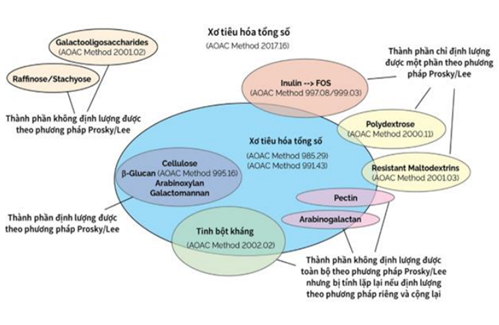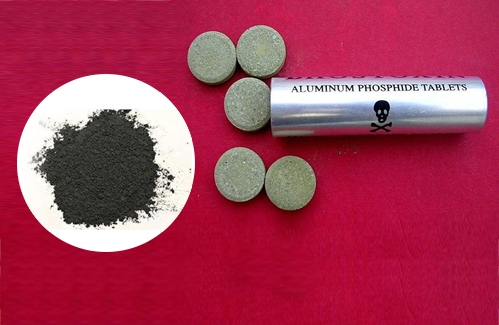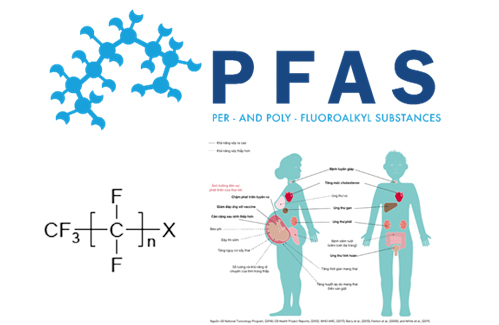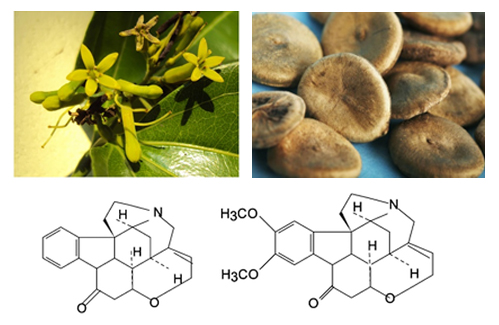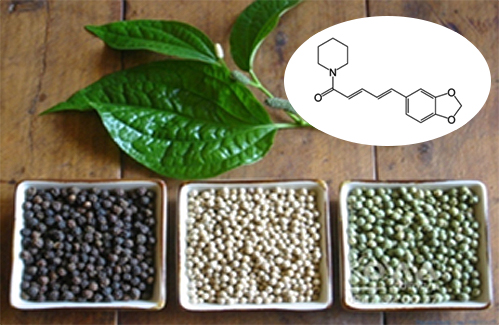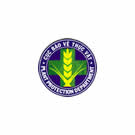- Folder Technical News
- Views 2699
- Last Updated 06/05/2024
Thornapple, a group plant considered as medicine, yet also has high toxicity. All parts of the plant are highly toxic if used inappropriately.
Adverse effects of thornapple on the human body might include dry mouth, thirst; increased heart rate; capable of affecting the nerves, causing delirium and hallucinations; especially their seeds and flowers can even cause death. In recent years, the National Institute for Food Control (NIFC) has determined the cause of many poisoning cases related to Datura datura and participated in communication activities for grassroots health officials and the people to prevent poisoning with datura.
1. Poisoning cases related to thornapple in Vietnam
In recent times, many localities have had reports of poisoning related to thornapple. During the period 2014 - 2022, the National Institute for Food Control (NIFC) has received several reports of poisoning related to datura as follows:
In July 2014, in Quang Ngai province: six people in a family were poisoned after eating thornapple soup. The patients had symptoms of mental disorder and vision loss when admitted to the hospital and were promptly treated. The cause was determined to be eating thornapple soup.
In March 2016, in Thanh Hoa province: four people were hospitalized in a state of psychosis after eating thornapple flowers and were promptly treated.
In December 2017, in Thai Binh province: seven people drank thornapple wine and showed signs of increased heart rate, sweating, dilated pupils, dry lips, dry mouth, watery eyes, and drowsiness.
In July 2020, in Lao Cai province: three out of eleven people ate processed thornapple leaves and had serious symptoms such as nausea and headaches. The cause was due to eating the top part of the plant containing toxins. They were treated at local hospitals and given emergency treatment promptly. Toxicological screening test results of the National Institute for Food Control (NIFC) found that the sample contained atropine, which is a tropane alkaloid from plants of the Solanaceae family.
In August 2023, in Dak Lak province: five family members had symptoms of vomiting and convulsions after eating rice with thornapple, transferred to Tay Nguyen General Hospital, diagnosed with thornapple poisoning, and emergency treatment timely rescue.
Thornapple contains many alkaloids, which not only have medicinal but also toxicity effects. Many people use thornapple to treat diseases such as motion sickness, joint pain, colds, high fever, bronchial asthma, asthma and some other diseases. However, if used in an inappropriate dosage or without consulting from the doctor, thornapple can cause poisoning. Up to now, there are still cases of thornapple poisoning occurring sporadically in localities, because people do not have adequate knowledge about how to use thornapple safely and effectively.
2. Identification of thornapple
Currently, two species of the Solanaceae family are called thornapple by local people, which are Datura metel L. and Solanum viarum Dunal.
Other names in Vietnam: Mạn đà la, Độc giã, Cà diên, Sùa tùa (H’mông), Plờn (Kho), Cà lục lược (Tày), Hìa kía piếu (Dao), Cà trái vàng, Cà tàu, Cà gai nepal, Cà gai độc.
2.1. Datura metel L.
- Scientific name: Datura metel L., family: Solanaceae
- Morphological description:
- Herbaceous, annual plant with the base of the trunk turning into a woody stem, growing annually, 1-2 m tall. The whole body is almost smooth, with many dermatoses. Young branches and young parts have many short hairs. The stem is green or purple, depending on the form.
- Leaves are simple, and spaced out, but near the tip of the branch, they look like they grow opposite or whorl. The leaf blade is egg-shaped, 9-10 cm long, and 4-9 cm wide, the leaf tip is pointed, and the bottom of the leaf is slightly narrower. The two sides of the leaf base are uneven. Leaf edges are rarely whole, often wavy or slightly serrated (3-4 serrated). The leaf surface is gray-green, the underside is light green, and the main and secondary veins are blue or purple depending on the form. Leaf stalks are 4-8 cm long. Leaves have many hairs when younger, then gradually fall off over time.
- Single flowers grow in leaf axils, petioles are 1-2 cm long. When the flowers wilt, the remaining portion matures with tray-shaped fruit. Purple flowers have purple spots on top.
- The fruit is spherical with a spiny exterior, about 3 cm in diameter, green when young, brown when ripe. When the fruit is old, it cracks in 3-4 lines or cracks haphazardly at the top. Seeds are many, ovoid, flat, yellow-black, 3-5 mm long, 1 mm thick, with embossed edges on the edges.
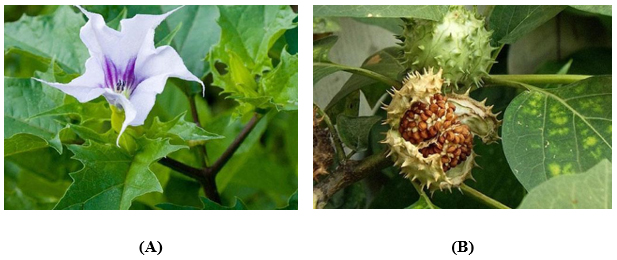
Figure 1. Datural metel L.
(A - Flower; B – Green and ripe fruit)
- Habitat: The tree originated in Peru and Mexico, introduced and widely distributed everywhere in Vietnam from low mountains to midlands and coastal plains. The plant often grows in moist soil in the garden or around the house, in deserted areas along roadsides, and in rocky areas along streams. Some provinces have a lot of datura growing wild such as Dien Bien, Ha Giang, Lao Cai, Son La, Ninh Thuan, Nghe An, Thanh Hoa, Thai Binh, Ninh Binh, Kien Giang, Tien Giang, Hau Giang, Ben Tre, Dong Thap, ... but the reserves are insignificant.
2.2. Solanum viarum Dunal
- Scientific name: Solanum viarum Dunal, family: Solanaceae
- Morphological description:
- Upright, herbaceous shrub, 50-80 cm tall, with many loose branches. The body is full of hairs and thorns; Thorns have a light green base, gradually turning yellow and then dark yellow, curved or straight; spines are more curved, sharp, and strong, 5-9 mm long and 3-4 mm wide; lesser straight, needle-like spines, 2-5 mm long and 0.7-1 mm wide.
- Leaves are simple, alternate, and without stipules; The flower-bearing part has two irregular leaves, growing perpendicularly in pairs. Leaf stalks have thorns. Leaf blades are triangular oval, size 11-12 x 10-12.5 cm, heart-shaped base, symmetrical or offset by 1-2 mm, each side has 4-6 shallow, irregular, hairy lobes and spikes on both sides; Thorns are only found on leaf veins, always straight, strong and strong, most are 15-20 mm long, a few are 4-10 mm long.
- Individual flowers in the middle of the internode and scorpion-shaped cyme, 3-4 flowers outside the leaf axils, of which 1-2 flowers are at the base attached closely to the stem. The flowers are even, pattern 5, white. Single flowers and flowers at the base of the cyme are bisexual flowers capable of bearing fruit; The remaining flowers in the inflorescence are male flowers, which fall off after blooming.
- The mature fruit is smooth, round, yellow when ripe, and 1.5 to 2.5 cm in diameter with a leathery shell surrounding a thin-layered, light green, fragrant pulp and 180 to 420 flat seeds, reddish brown. Each tree is capable of producing 200 or more fruits per year.
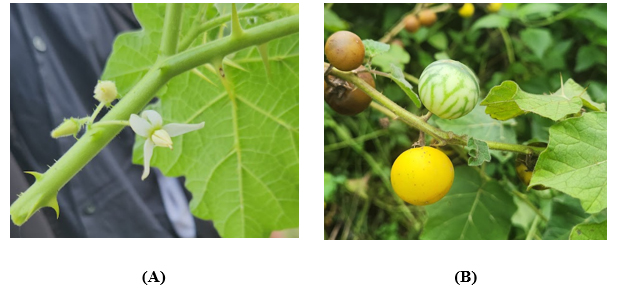
Figure 2. Solanum viarum Dunal
(A – Flower; B – Green and ripe fruit)
- Habitat: The tree originates from Brazil and Argentina, introduced and widely distributed everywhere in Vietnam from low mountains to midlands and coastal plains. The plant often grows in moist soil in the garden or around the house, in deserted areas along roadsides, and in rocky areas along streams. Some provinces have a lot of datura growing wild such as Dien Bien, Ha Giang, Lao Cai, Son La, Ninh Thuan, Nghe An, Thanh Hoa, Thai Binh, Ninh Binh, Kien Giang, Tien Giang, Hau Giang, Ben Tre, Dong Thap, ... but the reserves are insignificant.
Table 1. Some plants are easily confused with Datura metel L. and Solanum viarum Dunal
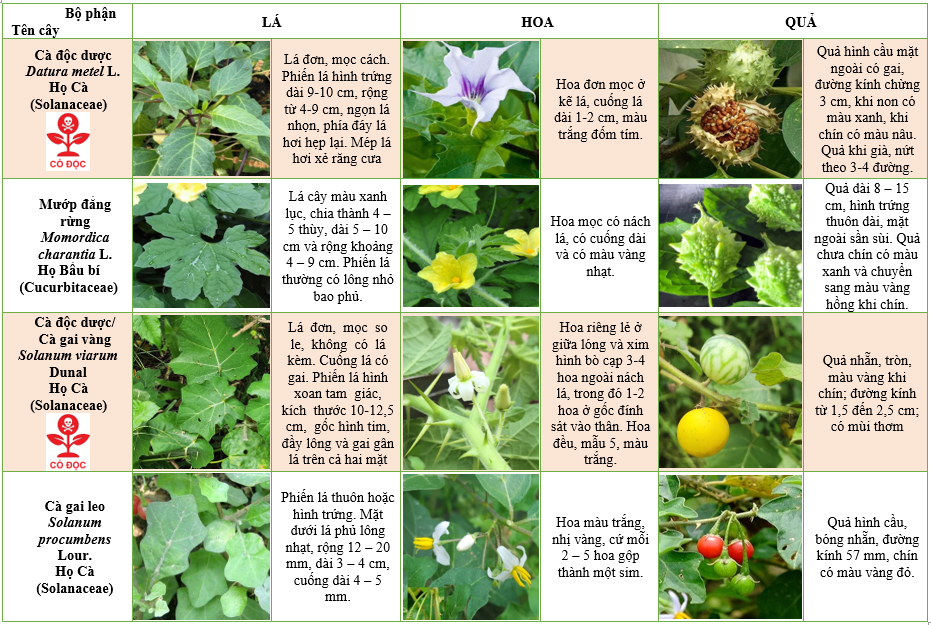
3. Toxicity of thornapple
Table 2. Toxicity of Datura metel L. and Solanum viarum Dunal
|
|
Datura metel L. |
Solanum viarum Dunal |
|
Toxin |
Tropane alkaloid (hyoscyamine, scopolamine and atropine) |
Steroidal alkaloid (solasodine, solamargine and solasonine) |
|
Lethal dose |
About 100 mg tropane alkaloid |
About 200 mg steroidal alkaloid |
|
Effective dose |
The difference between the effective dose and the toxic dose is very small |
|
|
Uses in traditional medicine |
Treats cough, asthma, stomachache, motion sickness, and Parkinson's disease and is used as a nerve-calming medicine |
Treats sore throat, tonsillitis, sinusitis, dermatitis, arthritis and acts as an antiseptic |
|
Side effects |
These alkaloids can cause itching, nausea, gastrointestinal disorders, liver toxicity, heart arrhythmia |
These alkaloids can cause allergic or toxic reactions to the liver, kidneys and heart |

Figure 3. Some typical toxic alkaloids of Datura metel L.
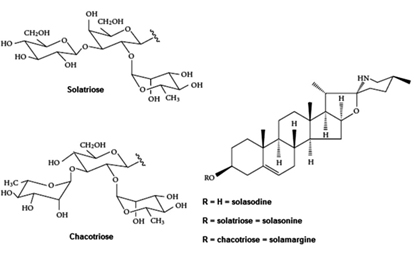
Figure 4. Some typical toxic alkaloids of Solanum viarum Dunal
4. Prevention and treatment of thornapple poisoning
a) Symptoms of thornapple poisoning
- Symptoms of poisoning appear about 5 - 30 minutes after eating/drinking.
+ Ear, nose, throat, eyes: Dilated pupils, dry mouth.
+ Cardiovascular: fast heart rate.
+ Abdominal bloating, urinary retention.
+ Nervous system: headache, dizziness, severe possible delirium, irritability.
+ Skin - mucous membranes: dry skin, pink or red.
b) Treatment of thornapple poisoning
Treatment of thornapple poisoning should be carried out according to two principles:
(1) Early, active, and urgent treatment;
(2) To ensure stable vital functions, especially to ensure respiratory control, quickly stop convulsion and stabilize circulation before applying other measures.
When detecting a case of poisoning related to thornapple, it is necessary to immediately treat the patient to induce vomiting and then promptly notify the medical authorities for handling. Specific measures to handle thornapple poisoning are as follows:
- Restriction of absorption: Including the following measures (performed and monitored by medical staff):
+ Induce vomiting: conducted when the patient has just finished eating, the patient is awake and cooperative. Only use mechanical measures (throat stimulation), and do not use drugs to induce vomiting because until the drug takes effect, the patient may vomit or have pharyngeal paralysis.
+ Gastric lavage: carried out when the patient has only eaten thornapple parts within 6 hours.
+ Use activated charcoal: Use after inducing vomiting or gastric lavage. Do not use during convulsions, respiratory failure, or coma without an endotracheal tube.
- Symptomatic treatment: After the patient is treated according to the above steps, it is necessary to closely monitor for signs of convulsions, bradycardia, and muscle paralysis that may lead to respiratory failure.
Supportive treatment measures are important, there is no specific antidote.
5. Propaganda activities to prevent thornapple poisoning
From September to December 2023, the National Institute of Food Control (NIFC) carried out the activity "Coordinating with authorities to propagate about the risk of poisoning" together with the Ha Giang Food Safety and Hygiene Department and Dien Bien Food Safety and Hygiene Department, with the result a set of propaganda materials (including posters and leaflets) to provide general information on poisoning, ways to prevent poisoning by mistake for health workers/propaganda staff, thereby guiding/propagating concise and concise information to the people.
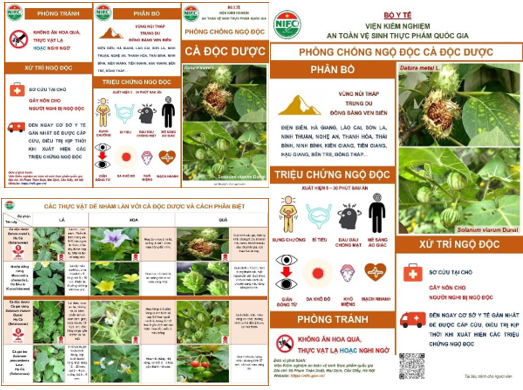
Figure 5. Propaganda leaflets and posters for local people
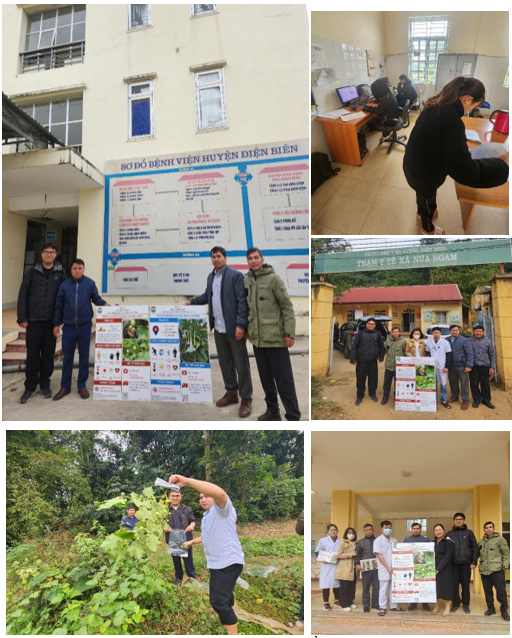
Figure 6. Propaganda activities at Dien Bien Province
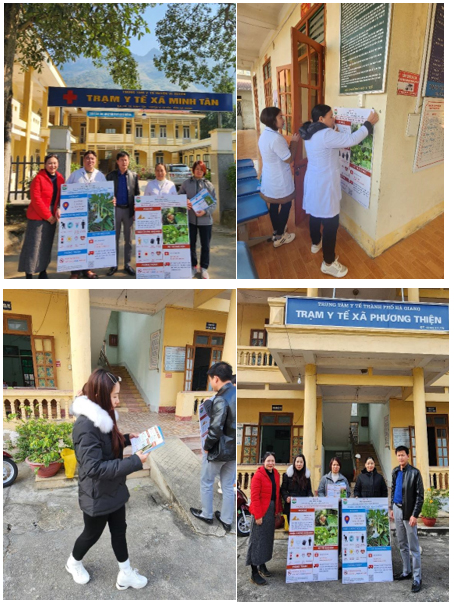
Figure 7. Propaganda activities at Ha Giang Province
With the desire to contribute to reducing the cases of poisoning caused by thornapple in particular and natural toxins in general, NIFC regularly conducts investigations and identification of the poisoning causes as well as poisoning prevention communication. Communication activities will help to prevent and limit cases of natural plant poisoning. At the same time, timely test results will help confirm the cause of poisoning and help doctors to direct treatment.
Leaflets with prevention of thornapple poisoning: Link
References
1. Bộ Y tế (2015). Quyết định số 3610/QĐ-BYT về ban hành tài liệu chuyên môn "Hướng dẫn chẩn đoán và xử trí ngộ độc".
2. Đỗ Tất Lợi (2004), Những cây thuốc và vị thuốc Việt Nam, Nhà xuất bản Giáo dục.
3. Liêu Hồ Mỹ Trang và Hồ Thị Bích Hằng (2014). Đặc điểm hình thái và vi hoặc của cây cà trái vàng (Solanum viarum Dunal) ở Miền Nam Việt Nam. Tạp Chí Học Thành Phố Hồ Chí Minh, 18(2), 457–463.
4. Chan T.Y.K. (2017). Worldwide Occurrence and Investigations of Contamination of Herbal Medicines by Tropane Alkaloids. Toxins, 9(9), 284.
5. Al-Sinani S., Eltayeb E., Yt K. và cộng sự. (2015). Variations in the cytotoxic glycoalkaloids (solamargine and solasonine) in different plant parts during development of Solanum incanum grown in Oman. J Taibah Univ Sci, 56.
6. Cổng Thông tin chính phủ (2021). Chủ động phòng chống ngộ độc do độc tố tự nhiên. Cổng Thông tin chính phủ, <https://baochinhphu.vn/chu-dong-phong-chong-ngo-doc-do-doc-to-tu-nhien-102302917.htm>





